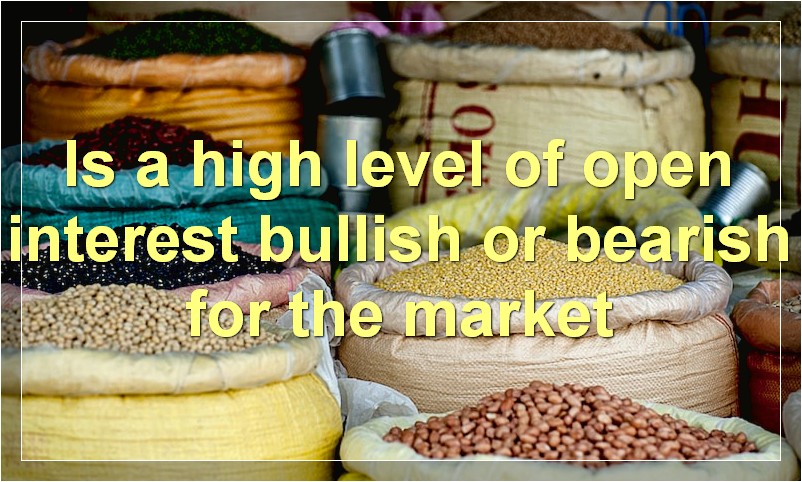If you’re new to trading stocks, you may have come across the term “open interest.” It’s important to understand what open interest is and how it can impact your trading strategy.
What is stock open interest
Open interest is the number of outstanding contracts (including both long and short positions) that have not yet been settled. It is a key metric for determining the liquidity of a security and the level of participation in a market.
A high level of open interest means that there are a lot of traders participating in the market and that there is a lot of liquidity, which is necessary for large trades to take place. A low level of open interest indicates that trading activity is low and that there may not be enough liquidity to support large trades.
Open interest can be used to gauge the sentiment of the market. If the open interest is increasing, it means that more traders are entering the market and buying the security, which is generally seen as a bullish sign. If the open interest is decreasing, it means that fewer traders are participating in the market and that there may be less demand for the security, which is generally seen as a bearish sign.
What does stock open interest signify

Stock open interest signifies the number of contracts that have not been closed out by an opposite transaction or by delivery.
How is stock open interest calculated
Open interest is the number of outstanding contracts (options or futures) that have not yet been liquidated by an offsetting transaction or fulfilled by delivery. It represents the total number of open contracts for a particular market. Open interest is calculated by taking the total number of contracts traded and subtracting out the number of positions that have been closed. The result is the number of open contracts that exist in the market.
What is the difference between open interest and volume
Open interest is the number of open contracts for a particular commodity. Volume is the number of trading contracts for a particular commodity.
How does open interest affect prices
Open interest is the total number of outstanding contracts that have not yet been settled. It is a measure of market activity and liquidity, as well as the level of commitment by market participants. When open interest is rising, it indicates that new money is entering the market and that there is more buying pressure. This can lead to prices rising as well. Conversely, when open interest is falling, it indicates that money is leaving the market and that there is more selling pressure. This can lead to prices falling.
Is a high level of open interest bullish or bearish for the market

When it comes to market speculation, there is no sure thing. However, when it comes to open interest, there is a general consensus among market participants that a high level of open interest is bullish for the market.
Open interest is defined as the total number of outstanding contracts in a given market. A contract is the agreement between two parties to buy or sell an asset at a specified price on a specified date. For example, in the stock market, a contract would be for 100 shares of XYZ stock at $10 per share.
The thinking behind this consensus is that a high level of open interest indicates strong demand for an asset. If there are a lot of outstanding contracts, it means that there are a lot of buyers and sellers interested in trading the asset. This usually leads to upward pressure on prices as buyers compete against each other to get their hands on the asset.
Of course, there are no guarantees in the markets and a high level of open interest can sometimes be a bearish sign. For example, if everyone who is interested in buying an asset has already bought it, then there may not be enough buyers left to push prices higher. However, in general, a high level of open interest is seen as a bullish sign for the market.
How can open interest be used in trading strategies
Open interest is the number of contracts for a particular asset that are not yet closed. This is important because it can give clues about future demand for the asset and how price may move.
There are two main ways that open interest can be used in trading strategies. The first is to use it as a leading indicator to predict future price movements. If open interest is increasing, this usually indicates that more people are buying the asset, which could lead to prices rising. Conversely, if open interest is decreasing, this could mean that fewer people are interested in the asset, which could lead to prices falling.
The second way to use open interest is to use it as a tool to manage risk. For example, if you are long on a stock and the open interest starts to increase, this could be a sign that prices may start to fall. In this case, you might want to consider selling some of your position to limit your losses.
Overall, open interest can be a helpful tool for traders when used correctly. It can be used to predict future price movements and help manage risk.
What are the risks associated with trading stocks with high levels of open interest
The risks associated with trading stocks with high levels of open interest are numerous. Firstly, there is the risk that the stock price will move against you, as there are more people interested in buying the stock than selling it. This can lead to you losing money on your investment. Secondly, there is the risk that the stock will be delisted from the exchange, as this can happen if the level of open interest falls below a certain level. This means that you would not be able to sell your shares, and would therefore lose all of your investment. Finally, there is the risk that the company itself will go bankrupt, which would mean that you would lose all of your investment.
What are some other factors that can affect stock prices besides open interest
There are a number of factors that can affect stock prices besides open interest. Some of these include the overall market conditions, the performance of the company, and the expectations of analysts.
Are there any benefits to trading stocks with high levels of open interest
Open interest is the number of outstanding contracts that are held by traders at the end of the day. It is a good indicator of market activity and momentum. A high level of open interest means that there are more traders interested in the stock, and a low level of open interest means that there are fewer traders interested in the stock.
There are several benefits to trading stocks with high levels of open interest. First, it indicates that there is high demand for the stock, which can lead to price increases. Second, it means that there is high liquidity in the market for the stock, which can make it easier to buy and sell the stock. Finally, it can be an indication of strong momentum in the stock, which can make it easier to make profits from trading the stock.

